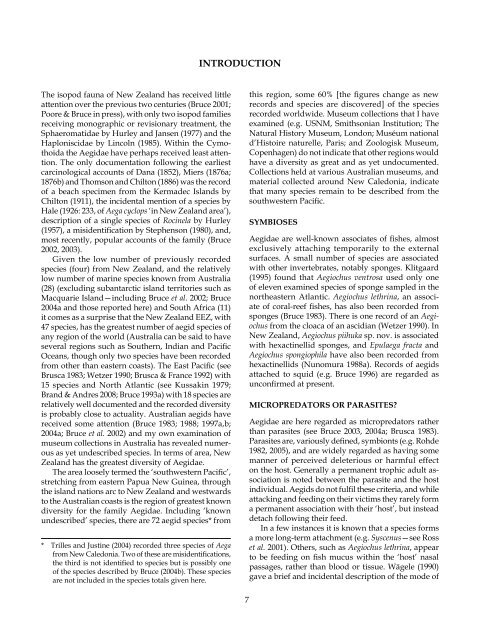The Marine Fauna of New Zealand: Isopoda, Aegidae (Crustacea)
The Marine Fauna of New Zealand: Isopoda, Aegidae (Crustacea)
The Marine Fauna of New Zealand: Isopoda, Aegidae (Crustacea)
You also want an ePaper? Increase the reach of your titles
YUMPU automatically turns print PDFs into web optimized ePapers that Google loves.
<strong>The</strong> isopod fauna <strong>of</strong> <strong>New</strong> <strong>Zealand</strong> has received little<br />
attention over the previous two centuries (Bruce 200 ;<br />
Poore & Bruce in press), with only two isopod families<br />
receiving monographic or revisionary treatment, the<br />
Sphaeromatidae by Hurley and Jansen ( 977) and the<br />
Haploniscidae by Lincoln ( 985). Within the Cymothoida<br />
the <strong>Aegidae</strong> have perhaps received least attention.<br />
<strong>The</strong> only documentation following the earliest<br />
carcinological accounts <strong>of</strong> Dana ( 852), Miers ( 876a;<br />
876b) and Thomson and Chilton ( 886) was the record<br />
<strong>of</strong> a beach specimen from the Kermadec Islands by<br />
Chilton ( 9 ), the incidental mention <strong>of</strong> a species by<br />
Hale ( 926: 233, <strong>of</strong> Aega cyclops ‘in <strong>New</strong> <strong>Zealand</strong> area’),<br />
description <strong>of</strong> a single species <strong>of</strong> Rocinela by Hurley<br />
(1957), a misidentification by Stephenson (1980), and,<br />
most recently, popular accounts <strong>of</strong> the family (Bruce<br />
2002, 2003).<br />
Given the low number <strong>of</strong> previously recorded<br />
species (four) from <strong>New</strong> <strong>Zealand</strong>, and the relatively<br />
low number <strong>of</strong> marine species known from Australia<br />
(28) (excluding subantarctic island territories such as<br />
Macquarie Island—including Bruce et al. 2002; Bruce<br />
2004a and those reported here) and South Africa ( )<br />
it comes as a surprise that the <strong>New</strong> <strong>Zealand</strong> EEZ, with<br />
47 species, has the greatest number <strong>of</strong> aegid species <strong>of</strong><br />
any region <strong>of</strong> the world (Australia can be said to have<br />
several regions such as Southern, Indian and Pacific<br />
Oceans, though only two species have been recorded<br />
from other than eastern coasts). <strong>The</strong> East Pacific (see<br />
Brusca 983; Wetzer 990; Brusca & France 992) with<br />
5 species and North Atlantic (see Kussakin 979;<br />
Brand & Andres 2008; Bruce 993a) with 8 species are<br />
relatively well documented and the recorded diversity<br />
is probably close to actuality. Australian aegids have<br />
received some attention (Bruce 983; 988; 997a,b;<br />
2004a; Bruce et al. 2002) and my own examination <strong>of</strong><br />
museum collections in Australia has revealed numerous<br />
as yet undescribed species. In terms <strong>of</strong> area, <strong>New</strong><br />
<strong>Zealand</strong> has the greatest diversity <strong>of</strong> <strong>Aegidae</strong>.<br />
<strong>The</strong> area loosely termed the ‘southwestern Pacific’,<br />
stretching from eastern Papua <strong>New</strong> Guinea, through<br />
the island nations arc to <strong>New</strong> <strong>Zealand</strong> and westwards<br />
to the Australian coasts is the region <strong>of</strong> greatest known<br />
diversity for the family <strong>Aegidae</strong>. Including ‘known<br />
undescribed’ species, there are 72 aegid species* from<br />
* Trilles and Justine (2004) recorded three species <strong>of</strong> Aega<br />
from <strong>New</strong> Caledonia. Two <strong>of</strong> these are misidentifications,<br />
the third is not identified to species but is possibly one<br />
<strong>of</strong> the species described by Bruce (2004b). <strong>The</strong>se species<br />
are not included in the species totals given here.<br />
INtrOductION<br />
7<br />
this region, some 60% [the figures change as new<br />
records and species are discovered] <strong>of</strong> the species<br />
recorded worldwide. Museum collections that I have<br />
examined (e.g. USNM, Smithsonian Institution; <strong>The</strong><br />
Natural History Museum, London; Muséum national<br />
d’Histoire naturelle, Paris; and Zoologisk Museum,<br />
Copenhagen) do not indicate that other regions would<br />
have a diversity as great and as yet undocumented.<br />
Collections held at various Australian museums, and<br />
material collected around <strong>New</strong> Caledonia, indicate<br />
that many species remain to be described from the<br />
southwestern Pacific.<br />
symbIOsEs<br />
<strong>Aegidae</strong> are well-known associates <strong>of</strong> fishes, almost<br />
exclusively attaching temporarily to the external<br />
surfaces. A small number <strong>of</strong> species are associated<br />
with other invertebrates, notably sponges. Klitgaard<br />
( 995) found that Aegiochus ventrosa used only one<br />
<strong>of</strong> eleven examined species <strong>of</strong> sponge sampled in the<br />
northeastern Atlantic. Aegiochus lethrina, an associate<br />
<strong>of</strong> coral-reef fishes, has also been recorded from<br />
sponges (Bruce 983). <strong>The</strong>re is one record <strong>of</strong> an Aegiochus<br />
from the cloaca <strong>of</strong> an ascidian (Wetzer 990). In<br />
<strong>New</strong> <strong>Zealand</strong>, Aegiochus piihuka sp. nov. is associated<br />
with hexactinellid sponges, and Epulaega fracta and<br />
Aegiochus spongiophila have also been recorded from<br />
hexactinellids (Nunomura 988a). Records <strong>of</strong> aegids<br />
attached to squid (e.g. Bruce 996) are regarded as<br />
unconfirmed at present.<br />
mIcrOprEdAtOrs Or pArAsItEs?<br />
<strong>Aegidae</strong> are here regarded as micropredators rather<br />
than parasites (see Bruce 2003, 2004a; Brusca 983).<br />
Parasites are, variously defined, symbionts (e.g. Rohde<br />
982, 2005), and are widely regarded as having some<br />
manner <strong>of</strong> perceived deleterious or harmful effect<br />
on the host. Generally a permanent trophic adult association<br />
is noted between the parasite and the host<br />
individual. Aegids do not fulfil these criteria, and while<br />
attacking and feeding on their victims they rarely form<br />
a permanent association with their ‘host’, but instead<br />
detach following their feed.<br />
In a few instances it is known that a species forms<br />
a more long-term attachment (e.g. Syscenus—see Ross<br />
et al. 200 ). Others, such as Aegiochus lethrina, appear<br />
to be feeding on fish mucus within the ‘host’ nasal<br />
passages, rather than blood or tissue. Wägele ( 990)<br />
gave a brief and incidental description <strong>of</strong> the mode <strong>of</strong>

















